2. 武警黄金部队第十一支队, 拉萨 850000
2. No. 11 Gold Geological Party of the Chinese Armed Police Force, Lhasa 850000, China
A型花岗岩最初定义为碱性(alkaline)、无水(anhydrous)和非造山(anorogenic)的花岗岩(Loiselle and Wones, 1979)。随着时间推移,A型花岗岩的定义与理解已不仅限于以上的3A特点(Bonin, 2007),如有过铝质的A型花岗岩,偶尔出现并非无水的A型花岗岩,以及形成于后造山环境而不是非造山环境的A型花岗岩等。从化学成分上,A型花岗岩可为过碱质、准铝质和弱过铝质,具有较高的Ga/Al比值和富集HFSE(Zr、Nb、Ce、Y),这些微量元素特点是判别A型花岗岩的重要地球化学标志(Whalen et al., 1987)。过碱质A型花岗岩中通常会出现如霓石-霓辉石、钠闪石-钠铁闪石、铁橄榄石等含碱性暗色矿物的矿物学标志(吴福元等, 2007)。另外,有别于铝质A型花岗岩,过碱质A型花岗岩被认为由幔源岩浆(可混染部分陆壳)分异形成(Bonin, 1990, 2007; Jahn et al., 2009; Shellnutt et al., 2009; Dostal et al., 2014)。由于除了非造山环境外,还可形成于后造山环境,据构造环境进而将A型花岗岩划分出非造山型和后造山型。相对于非造山型的产生于大陆裂谷和与地幔柱有关的板内非造山环境,后造山型的则产生于陆-陆碰撞后或与俯冲作用有关的环境(Brown et al., 1984; Sylvester, 1989; Eby, 1990, 1992; Hong et al., 1996; Whalen et al., 1996; Förster et al., 1997; Barbarin, 1999; Shi et al., 2004; 张家菁等, 2009)。这种分类相当于Eby划分的A1和A2亚类,以及Hong划分的AA和PA亚类(Eby, 1990, 1992; Hong et al., 1996)。然而,已报导的属于俯冲拉张环境下的A型花岗岩实例有限,主要有扬子板块西缘新元古代的大相岭A型花岗岩(Zhao et al., 2008)、华夏板块侏罗纪金鸡岭A型花岗岩和西山A型花岗岩(Jiang et al., 2009)以及土耳其东Pontides地区白垩纪A型花岗岩(Karsli et al., 2012)。
北祁连造山带由蛇绿岩、高压低温变质岩和弧岩浆岩组成(冯益民和何世平, 1995; 夏林圻等, 1996; 宋述光, 1997; 张旗等, 1997; 张招崇等, 1998; 钱青等, 2001; 史仁灯等, 2004; Tseng et al., 2007; 相振群等, 2007; Xia and Song, 2010; 武鹏等, 2012; 夏小洪等, 2012; Xia et al., 2012; Song et al., 2013; Chen et al., 2014)。在垂直于北西-南东的区域构造线方向上,自北往南将其划分为北蛇绿岩带、弧岩浆岩带和南蛇绿岩带,高级蓝片岩相俯冲杂岩带以岩片形式呈北西-南东向出露于弧岩浆岩带中(夏林圻等, 1996; Song et al., 2013)。在此岩带划分中,北蛇绿岩带为弧后盆地的SSZ型蛇绿岩(冯益民和何世平, 1995; 夏林圻等, 1996; 张旗等, 1997; 钱青等, 2001; Xia and Song, 2010)。前人认为古祁连洋板片早古生代向北俯冲(夏林圻等, 1996; Tseng et al., 2007; 夏小洪等, 2012; Song et al., 2013),南蛇绿岩带形成于洋中脊环境,多被认为是该大洋岩石圈残片,主要依据是其中玄武岩或辉绿岩具有MORB特点(夏林圻等, 1996; 左国朝和吴汉泉, 1997; 史仁灯等, 2004; Tseng et al., 2007; 夏小洪等, 2012)。本次研究中以在北祁连南蛇绿岩带川刺沟地区发现的A型花岗岩以及其周围的超基性岩为研究对象,分析了相应的岩相学、地球化学及花岗岩锆石SHRIMP U-Pb年龄,以期能够更加清晰地认识北祁连南带形成的大地构造环境及演化。
1 地质背景及岩相学川刺沟A型花岗岩位于祁连县野牛沟乡西15km处的川刺沟,研究区位置上位于北祁连造山带南蛇绿岩带的中段(图 1)。北祁连造山带位于青藏高原北缘,南侧为祁连地块,北侧为阿拉善地块(Song et al., 2013),沿北西-南东向延伸约1000km,被阿尔金断裂在北西侧截断。研究区出露地层主要为下奥陶统阴沟群,由中基性火山岩、火山角砾岩、凝灰岩、砂岩、砾岩和板岩组成,地层受构造活动强烈改造。该区断裂构造发育,以北西-南东向断裂为主,规模较大、延伸远,为区域性托莱山北坡大断裂的组成部分。

|
图 1 北祁连造山带区域地质简图(据Song et al., 2013修改) Fig. 1 Simplified regional geological map of the North Qilian orogenic belt (modified after Song et al., 2013) |
研究区内出露基性-超基性岩体,主要由蛇纹岩和辉长岩组成,多沿断裂分布,沿北西-南东构造线方向展布,向西一直延伸到红土沟。区内中酸性侵入岩出露较少,仅发现规模较小的花岗岩和正长岩被超基性岩包围。
川刺沟A型花岗岩出露于超基性岩分布区中,北西向延伸,长约1000m,露头不连续,较大露头约为10m×6m(图 2)。岩石新鲜面呈灰白色,块状构造。具条纹结构和显微文象结构(图 3a, b)。主要由碱性长石(~45%)、石英(~30%)、斜长石(~15%)和霓辉石(~5%),以及副矿物锆石和榍石等组成(图 3c, d)。其中,碱性长石主要呈他形粒状,少量宽板状,大小一般0.2~2.0mm,个别达3.0mm,多由细脉状、网状的条纹长石组成。石英呈他形粒状,大小一般0.2~2.0mm。斜长石呈半自形板状,大小一般0.2~1.0mm,多具细而密的聚片双晶。根据⊥(010)晶带的最大消光角法测得Np'∧(010)=14,斜长石牌号An=30,属于更长石。霓辉石多为半自形和他形,镜下呈浅绿色(图 3c),其Na2O含量为4.64%~6.57%,Fe2O3含量为10.28%~16.73%(表 1)。综合以上矿物组成及结构,以及霓辉石的出现,显示该花岗岩过碱,符合A型花岗岩特征(Eby, 1990; 吴福元等, 2007)。
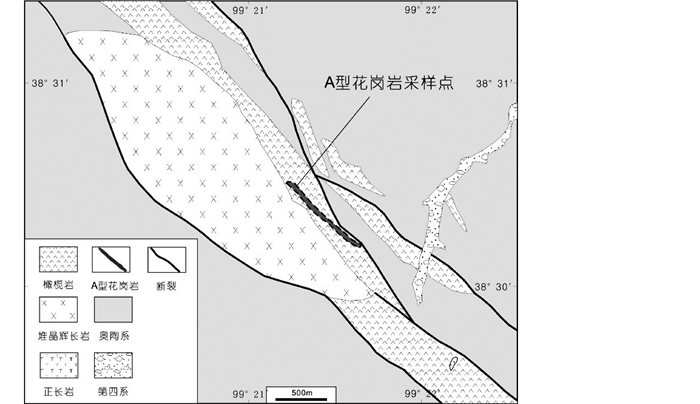
|
图 2 川刺沟地区地质简图(据武警黄金第六支队, 2012修改①) Fig. 2 Simplified geological map of Chuancigou |
① 武警黄金第六支队. 2012.红土沟-川刺沟地区1:10000综合地质图
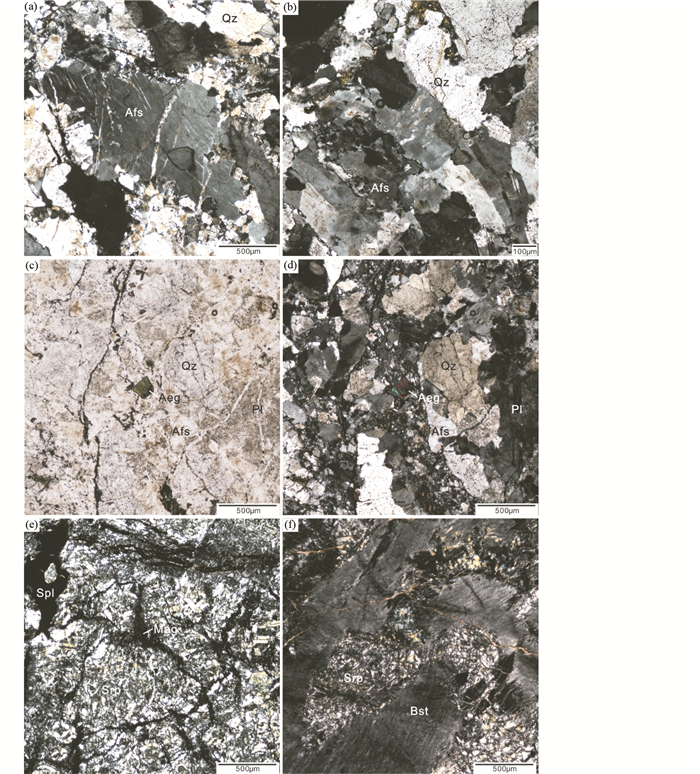
|
图 3 川刺沟A型花岗岩和超基性岩显微照片 (a)条纹结构;(b)显微文象结构;(c)花岗岩矿物组成(单偏光);(d)花岗岩矿物组成(正交偏光);(e)网脉状蛇纹石;(f)港湾状绢石. Afs-碱性长石;Qz-石英;Pl-斜长石;Aeg-霓辉石;Srp-蛇纹石;Bst-绢石;Spl-铬尖晶石;Mag-磁铁矿,缩写据Whitney and Evans, 2010 Fig. 3 Photomicrographs of the Chuancigou A-type granite and ultrabasic rock (a) perthite texture; (b) micrographic texture; (c) mineral assemblages of the Chuancigou A-type granite (plane polarizer); (d) mineral assemblages of the Chuancigou A-type granite (crossed polarizer); (e) mesh serpentine; (f) embayed bastite. abbreviation: Afs-alkali feldspar; Qz-quartz; Pl-plagioclase; Aeg-agerine augite; Srp-serpentine; Bst-bastite; Spl-spinel; Mag-magnetite, Abbr. after Whitney and Evans, 2010 |
|
|
表 1 川刺沟A型花岗岩中霓辉石电子探针数据(wt%) Table 1 Electron microprobe analysis of aegirine augite of the Chuancigou A-type granite (wt%) |
花岗岩周围为呈墨绿色超基性岩,蛇纹石化显著,组成矿物为蛇纹石(~90%),铬尖晶石(~6%)和磁铁矿(~4%)等。蛇纹石有两类,一类(~50%)呈网脉状(图 3e),具有橄榄石假象,颗粒边界清晰,局部具镶嵌等粒结构;另一类(~40%)为绢石,仍保留斜方辉石形态,多呈港湾状(图 3f)。铬尖晶石(~6%)颗粒内部暗红色,多呈不规则状和港湾状。磁铁矿(~4%)主要沿颗粒间隙分布,少量呈星点状。
2 地球化学岩石地球化学成分分析在河北省区域地质矿产调查研究所完成。测试前将岩石样品研磨至200目,主量元素和Zr采用Axiosmax X射线荧光光谱仪(XRF)测定。其中Fe2+采用滴定法测试(检测方法代号为GB/T 14506.14—2010),H2O+采用重量法测试(检测方法代号为GB/T 14506.2—2010)。微量元素采用X Serise 2等离子体质谱仪(ICP-MS)进行分析(检测方法代号为DZG20-1)。其中,主量元素分析精度和准确度优于5%,微量元素的分析精度和准确度优于10%。
岩石化学成分分析结果显示(表 2)川刺沟花岗岩具高硅(72.58%~73.96%)、富碱(Na2O+K2O=10.12%~10.39%)和高FeOT/(FeOT+MgO)的特点。岩石A/NK为0.97~0.99,岩石碱度率(AR)为6.2~6.6。花岗岩稀土配分型式(图 4a)呈海鸥形,轻稀土明显富集,轻重稀土分馏明显,(La/Yb)N为10.4~16.8,负Eu异常(δEu=0.56~0.60)。微量元素标准化型式显示样品相对富集Rb、Ba、Th、K,强烈亏损Sr、P、Ti、Nb、Ta(图 4b)。10000Ga/Al对K2O+Na2O、FeOT/MgO、Zr、Nb图解显示,除HC-1的10000Ga/Al值为2.59在靠近边界处I & S区外,其它点均落入A型花岗岩区域(图 5)。上述特征符合A型花岗岩标准(Loiselle and Wones, 1979; Eby, 1990; Frost et al., 2001)。
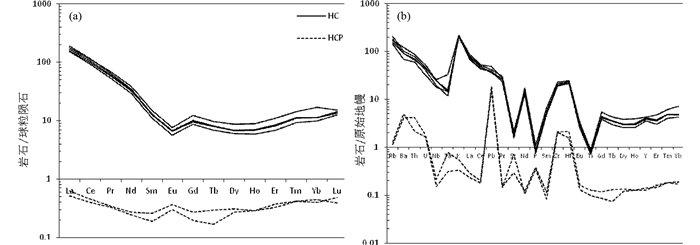
|
图 4 川刺沟A型花岗岩(HC)和超基性岩(HCP)球粒陨石标准化稀土元素配分图(a, 标准化值据Boynton, 1984)和原始地幔标准化微量元素蛛网图(b, 标准化值据Sun and McDonough, 1989) Fig. 4 Chondrite-normalized REE diagram (a, normalization values after Boynton, 1984) and primitive mantle-normalized trace element diagram for the Chuancigou A-type granite (HC) and ultrabasic rock (HCP) (b, normalization values after Sun and McDonough, 1989) |
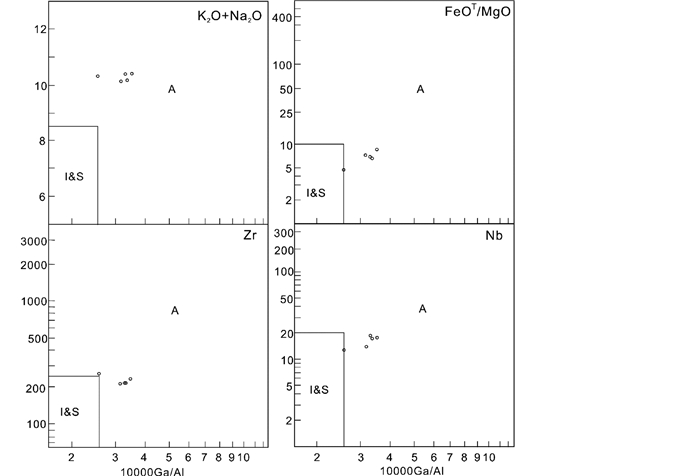
|
图 5 川刺沟A型花岗岩10000Ga/Al对K2O+Na2O、FeOT/MgO、Zr和Nb图解(底图据Whalen et al., 1987) Fig. 5 10000Ga/Al vs. K2O+Na2O, FeOT/MgO, Zr and Nb diagrams of the Chuancigou A-type granite (after Whalen et al., 1987) |
|
|
表 2 川刺沟A型花岗岩和超基性岩化学成分分析(主量元素:wt%;稀土和微量元素:×10-6) Table 2 Chemical analysis of the Chuancigou A-type granite and ultrabasic rock (major elements: wt%; trace elements: ×10-6) |
超基性岩具有较高的烧失量(13.19%~13.47%),归一化后岩石具高MgO(41.25%~42.29%)、和较低的TiO2(0.02%~0.03%)、Al2O3(1.67%~1.81%)和CaO(0.23%~0.55%)。FeOT为(8.70%~8.22%)。CIPW标准化后的主要矿物组成为橄榄石(43%~47%)和斜方辉石(43%~46%)。根据IUGS(Streckeisen, 1976)可将其原岩恢复为方辉橄榄岩。
川刺沟超基性岩稀土元素标准化型式呈“U”型,LREE相对富集,(La/Yb)N为1.15~1.58,(La/Sm)N为2.41~2.70,δEu为1.38~1.55。微量元素型式显示,岩石富集大离子亲石元素Ba、Pb、Sr和高场强元素Th、Zr、Hf。Th、Zr、Hf和LREE的相对富集,暗示该岩石可能受到俯冲地壳熔/流体的交代和改造(Niu, 2004; Paulick et al., 2006; Zheng, 2012)。
3 SHRIMP锆石U-Pb定年SHRIMP锆石定年样品为新鲜的A型花岗岩(样品号:HC-1,采样点位置:38°30′28″N、99°21′06″E)。锆石挑选在河北省区域地质矿产调查研究所采用破碎、淘洗和重液分离,然后进行电磁分离,最后在双目显微镜下手工挑选完成。锆石制靶后,在北京离子探针中心获得其阴极发光图像。锆石U-Pb同位素定年也在该中心用SHRIMP-Ⅱ离子探针仪分析。使用标样SL13(572Ma)标定所测样品的锆石U、Th、Pb含量,再用标样TEM(417Ma, Black et al., 2004)进行元素间的分馏校正,根据实测204Pb校正普通Pb,样品分析原理及流程详见文献Williams, 1998。测试过程中仪器质量分辨率约为5000,一次离子流束斑大小为25μm,每分析3~4个样品点进行一次TEM标样测定。实验数据处理以及谐和图的绘制采用SQUID和ISOPLOT软件(Ludwig, 2000, 2001)。测试结果列于表 3,其中单个数据误差为1σ,加权平均年龄计算时采用206Pb/238U年龄值,误差为2σ。
|
|
表 3 川刺沟A型花岗岩SHRIMP锆石U-Pb分析结果 Table 3 SHRIMP U-Pb analysis on zircons of the Chuancigou A-type granite |
所分析锆石具有规则的韵律生长环带(图 6),其Th/U介于0.35~1.69,为典型岩浆成因锆石。除点05、08、11、16、18外(或因远离主体年龄,或因U含量过高),对其它所测17个点的数据进行分析计算,得到一组谐和加权平均年龄值501±5Ma。该值可看作该花岗岩的侵位年龄(图 7)。
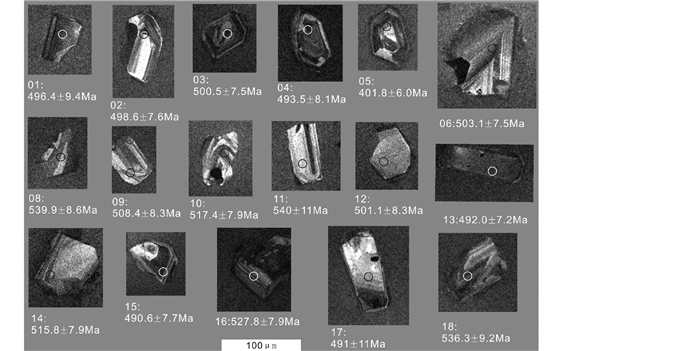
|
图 6 川刺沟A型花岗岩锆石阴极发光图片及测点位号和年龄值 Fig. 6 CL image of zircons of the Chuancigou A-type granite, their analysis spot No. and U-Pb age |
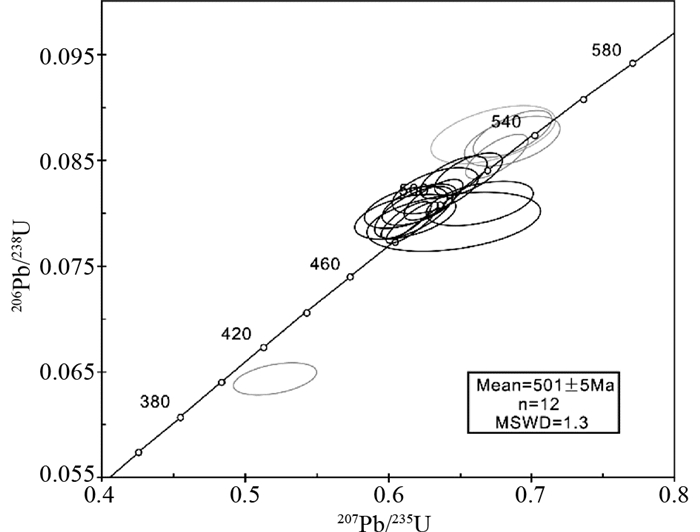
|
图 7 川刺沟A型花岗岩SHRIMP锆石U-Pb谐和图及加权平均年龄(未进行加权平均年龄计算的用灰线表示) Fig. 7 SHRIMP zircon concordia diagram and the weighted mean age of the Chuancigou A-type granite (the gray ones are excluded when calculating the weighted mean age) |
川刺沟花岗岩属于A2型。在Eby (1992)的Rb/Nb-Y/Nb图解中(图 8a),多数样品点分布在A2区内(图 8a);在Nb-Y-Ce图解(图 8b)中样品点分布在A1和A2界限附近(图 8b)。Eby判别图解使用的数据非孤立的划分为两个区域,其数据是一个连续的系列:从A2区域的后碰撞环境,到A1-A2边界处的后造山环境,再到A1区域的非造山环境(Bonin, 2007)。在Hong et al. (1996)的判别图解(图 8c)中,样品点投在PA区域中。由于微量元素标准化型式中Ba未显示负异常,暗示该花岗岩为后造山碱性花岗岩(Pearce et al., 1984; Bonin, 1990),与板内环境的A1型有区别。陆-陆碰撞后或与俯冲作用有关的环境均可产生A2型花岗岩。然前人研究中,形成于陆-陆碰撞后造山环境的A2型花岗岩实例较多,与俯冲环境有关的却鲜有讨论。虽然如此,最近还是发现了与俯冲作用有关的A2型花岗岩(Zhao et al., 2008; Jiang et al., 2009; Karsli et al., 2012),这说明活动大陆边缘可能是A2型花岗岩中常见的产出环境。

|
图 8 川刺沟A型花岗岩Rb/Nb-Y/Nb、Nb-Y-Ce和10000Ga/Al-R1图解(底图据Eby, 1992;Hong et al., 1996) Fig. 8 Rb/Nb vs. Y/Nb, Nb-Y-Ce and R1 vs. 10000Ga/Al diagrams of the Chuancigou A-type granite (after Eby, 1992; Hong et al., 1996) |
川刺沟A型花岗岩形成于活动大陆边缘环境。Song et al. (2013)结合前人研究,认为北祁连海底扩张开始于~710Ma之前,于~440Ma出现陆-陆碰撞。Xu et al. (2015)认为熬油沟朱龙关群玄武岩形成于大陆裂谷环境,600~580Ma为北祁连裂谷作用时间。这些研究都认为北祁连大陆裂谷化发生在新元古代,陆-陆碰撞开始于~440Ma。川刺沟A型花岗岩形成于501±5Ma,由于该时间晚于北祁连裂谷作用时间,早于北祁连陆-陆碰撞之后的造山时间,故其形成与北祁连裂谷化作用和陆-陆碰撞后造山作用无直接的关联性。另外,由于川刺沟海相火山-沉积岩在奥陶系广泛发育,该A型花岗岩的陆-陆碰撞后造山环境可能性同样地被排除,和韩宝福等(2010)提出的后碰撞型“钉合岩体”不同。因此该A2型花岗岩形成于活动大陆边缘环境而非陆-陆碰撞后造山环境。前人在北祁连该时期发现的俯冲作用证据进一步支持该结论。大岔大坂拉斑玄武岩-玻安岩体被认为是在517Ma古祁连洋开始发生俯冲时,地幔楔部分熔融所形成,且岩浆作用一直持续到487Ma(Xia et al., 2012)。在幔源岩浆底侵的影响下,陆壳发生熔融形成中酸性岩体,如规模较大的柴达诺花岗岩基,该岩基年龄(516Ma)与大岔大坂拉斑玄武岩的形成年龄一致(Chen et al., 2014)。其他相关研究中,认为北祁连弧岩浆作用一直持续到460Ma(Tseng et al., 2009; Wu et al., 2011; Song et al., 2013)。因此川刺沟A型花岗岩为活动大陆边缘拉张环境下形成。形成于大陆边缘深水盆地的与蛇绿岩相伴生的硅质岩可视为支持这一观点的沉积学证据(Du et al., 2007; 陆静云等, 2014)。形成于495±14Ma的川刺沟地区辉石玄武岩(夏林圻等, 1996)的幔源母岩浆可能为形成A型花岗岩提供了热源或物源。
川刺沟超基性岩亏损程度较高,“U”型稀土型式和Th、Zr、Hf明显的相对富集,说明该岩体可能受到俯冲板片熔/流体交代。值得注意的是,川刺沟超基性岩与玉石沟超基性岩可能具有相似的形成过程,两者稀土型式相似,都呈“U”型且同属南蛇绿岩带。但川刺沟超基性岩稀土含量较高,为相对较低程度的部分熔融所致。从矿物组成、全岩微量元素含量和包裹体特点可以看出玉石沟超基性岩可能为弧前位置地幔楔部分熔融后的残余,受到俯冲板片熔体的交代(Song et al., 2009)。
川刺沟A2型花岗岩的确定,对于理解北祁连造山带,特别是北祁连南蛇绿岩带的构造演化具有重要意义。北祁连北蛇绿岩带为弧后盆地的SSZ型蛇绿岩(冯益民和何世平, 1995; 夏林圻等, 1996; 张旗等, 1997; 钱青等, 2001; Xia and and Song, 2010)。依据俯冲杂岩带、弧岩浆岩带和北蛇绿岩带共同组成沟-弧-盆体系,前人推测古祁连洋在早古生代发生向北俯冲,南蛇绿岩带中具MORB特点的玄武岩或辉绿岩可视为洋中脊环境中形成(夏林圻等, 1996; Tseng et al., 2007; 夏小洪等, 2012)。然而,具有MORB特点的玄武岩并不只形成于大洋中脊环境,在弧后盆地和弧前盆地环境中也可产生(Crawford et al., 1981; Reagan et al., 2010; Dilek and Furnes, 2011; Xia et al., 2012)。在北祁连南蛇绿岩带中发现的A型花岗岩和超基性岩体不是形成于大洋中脊,而与俯冲有关。南蛇绿岩带中的超基性岩可能并非经典定义的、代表大洋岩石圈残片的蛇绿岩。
5 结论(1) 川刺沟花岗岩具有A型花岗岩特点,属于A2亚型,形成于活动大陆边缘拉张环境。超基性岩为蛇纹石化方辉橄榄岩,可能形成于俯冲环境,并非经典定义的、代表大洋岩石圈残片的蛇绿岩。
(2) 川刺沟A型花岗岩的侵位年龄为501±5Ma。推测该A型花岗岩是在中-晚寒武世俯冲作用影响下,北祁连活动大陆边缘弧前拉张,导致软流圈上涌发生部分熔融,进而产生幔源岩浆发生底侵形成的。
致谢 野外地质调查中得到了牛建、杨东秀和武警黄金第六支队官兵的帮助和支持;测试过程中得到了北京离子探针中心刘敦一,河北省区域地质矿产调查研究所李世平和中国科学院地质与地球物理研究所毛骞和马玉光等的帮助和支持;论文修改中得益于审稿人和编辑的建设性的修改意见;在此谨致衷心谢意!
Barbarin B. 1999. A review of the relationships between granitoid types, their origins and their geodynamic environments. Lithos, 46(3): 605-626. DOI:10.1016/S0024-4937(98)00085-1 |
Black LP, Kamo SL, Allen CM, Davis DW, Aleinikoff JN, Valley JW, Mundil R, Campbell IH, Korsch RJ, Williams IS and Foudoulis C. 2004. Improved 206Pb/238U microprobe geochronology by the monitoring of a trace-element-related matrix effect: SHRIMP, ID-TIMS, ELA-ICP-MS and oxygen isotope documentation for a series of zircon standards. Chemical Geology, 205(1-2): 115-140. DOI:10.1016/j.chemgeo.2004.01.003 |
Bonin B. 1990. From orogenic to anorogenic settings: Evolution of granitoid suites after a major orogenesis. Geological Journal, 25(3-4): 261-270. DOI:10.1002/(ISSN)1099-1034 |
Bonin B. 2007. A-type granites and related rocks: Evolution of a concept, problems and prospects. Lithos, 97(1-2): 1-29. DOI:10.1016/j.lithos.2006.12.007 |
Boynton WV. 1984. Geochemistry of the rare earth elements: Meteorite studies. In: Henderson P (ed. ). Rare Earth Elements Geochemistry. Amsterdam: Elsevier, 63-114
|
Brown GC, Thorpe RS and Webb BC. 1984. The geochemical characteristics of granitoids in contrasting arcs and comments on magma sources. Journal of the Geological Society, 141(3): 413-426. DOI:10.1144/gsjgs.141.3.0413 |
Chen YX, Song SG, Niu YL and Wei CJ. 2014. Melting of continental crust during subduction initiation: A case study from the Chaidanuo peraluminous granite in the North Qilian suture zone. Geochimica et Cosmochimica Acta, 132: 311-336. DOI:10.1016/j.gca.2014.02.011 |
Crawford AJ, Beccaluva L and Serri G. 1981. Tectono-magmatic evolution of the West Philippine-Mariana region and the origin of boninites. Earth and Planetary Science Letters, 54(2): 346-356. DOI:10.1016/0012-821X(81)90016-9 |
Dilek Y and Furnes H. 2011. Ophiolite genesis and global tectonics: Geochemical and tectonic fingerprinting of ancient oceanic lithosphere. Geological Society of America Bulletin, 123(3-4): 387-411. DOI:10.1130/B30446.1 |
Dostal J, Kontak DJ and Karl SM. 2014. The Early Jurassic Bokan Mountain peralkaline granitic complex (southeastern Alaska): Geochemistry, petrogenesis and rare-metal mineralization. Lithos, 202-203: 395-412. DOI:10.1016/j.lithos.2014.06.005 |
Du YS, Zhu J, Gu SZ, Xu YJ and Yang JH. 2007. Sedimentary geochemistry of the Cambrian-Ordovician cherts: Implication on archipelagic ocean of North Qilian orogenic belt. Science in China (Series D), 50(11): 1628-1644. DOI:10.1007/s11430-007-0111-z |
Eby GN. 1990. The A-type granitoids: A review of their occurrence and chemical characteristics and speculations on their petrogenesis. Lithos, 26(1-2): 115-134. DOI:10.1016/0024-4937(90)90043-Z |
Eby GN. 1992. Chemical subdivision of the A-type granitoids: Petrogenetic and tectonic implications. Geology, 20(7): 641-644. DOI:10.1130/0091-7613(1992)020<0641:CSOTAT>2.3.CO;2 |
Feng YM and He SP. 1995. Research for geology and geochemistry of several ophiolites in the North Qilian Mountains, China. Acta Petrologica Sinica, 11(Suppl.): 125-146. |
Förster HJ, Tischendorf G and Trumbull RB. 1997. An evaluation of the Rb vs. (Y + Nb) discrimination diagram to infer tectonic setting of silicic igneous rocks. Lithos, 40(2-4): 261-293. DOI:10.1016/S0024-4937(97)00032-7 |
Frost BR, Barnes CG, Collins WJ, Arculus RJ, Ellis DJ and Frost CD. 2001. A geochemical classification for granitic rocks. Journal of Petrology, 42(11): 2033-2048. DOI:10.1093/petrology/42.11.2033 |
Han BF, Guo ZJ and He GQ. 2010. Timing of major suture zones in North Xinjiang, China: Constraints from stitching plutons. Acta Petrologica Sinica, 26(8): 2233-2246. |
Hong DW, Wang SG, Han BF and Jin MY. 1996. Post-orogenic alkaline granites from China and comparisons with anorogenic alkaline granites elsewhere. Journal of Southeast Asian Earth Sciences, 13(1): 13-27. DOI:10.1016/0743-9547(96)00002-5 |
Jahn BM, Litvinovsky BA, Zanvilevich AN and Reichow M. 2009. Peralkaline granitoid magmatism in the Mongolian-Transbaikalian Belt: Evolution, petrogenesis and tectonic significance. Lithos, 113(3-4): 521-539. DOI:10.1016/j.lithos.2009.06.015 |
Jiang YH, Jiang SY, Dai BZ, Liao SY, Zhao KD and Ling HF. 2009. Middle to Late Jurassic felsic and mafic magmatism in southern Hunan Province, Southeast China: Implications for a continental arc to rifting. Lithos, 107(3-4): 185-204. DOI:10.1016/j.lithos.2008.10.006 |
Karsli O, Caran S, Dokuz A, Çoban H, Chen B and Kandemir R. 2012. A-type granitoids from the eastern Pontides, NE Turkey: Records for generation of hybrid A-type rocks in a subduction-related environment. Tectonophysics, 530-531: 208-224. DOI:10.1016/j.tecto.2011.12.030 |
Loiselle MC and Wones DR. 1979. Characteristics and origin of anorogenic granites. Geological Society of America Abstracts with Programs, 11(7): 468. |
Lu JY, Wang ZL, Du LK, Zhang HY, Xu WJ and Wang YQ. 2014. The characteristics and tectonic significance of Ordovician siliceous rocks in the Yushigou area, North Qilian. Rock and Mineral Analysis, 33(5): 747-757. |
Ludwig KR. 2000. User's manual for Isoplot/Ex Version 2.2: A geochronological toolkit for Microsoft Excel. Berkeley: Berkeley Geochronology Center Special Publication, No.1a: 1-50. |
Ludwig KR. 2001. Suqid 1.02: A user's manual. Berkeley: Berkeley Geochronology Center Special Publications, No.2: 1-19. |
Niu YL. 2004. Bulk-rock major and trace element compositions of abyssal peridotites: Implications for mantle melting, melt extraction and post-melting processes beneath mid-ocean ridges. Journal of Petrology, 45(12): 2423-2458. DOI:10.1093/petrology/egh068 |
Paulick H, Bach W, Godard M, De Hoog JCM, Suhr G and Harvey J. 2006. Geochemistry of abyssal peridotites (Mid-Atlantic Ridge, 15°20'N, ODP Leg 209): Implications for fluid/rock interaction in slow spreading environments. Chemical Geology, 234(3-4): 179-210. DOI:10.1016/j.chemgeo.2006.04.011 |
Pearce JA, Harris NBW and Tindle AG. 1984. Trace element discrimination diagrams for the tectonic interpretation of granitic rocks. Journal of Petrology, 25(4): 956-983. DOI:10.1093/petrology/25.4.956 |
Qian Q, Zhang Q and Sun XM. 2001. Tectonic setting and mantle source characteristics of Jiugequan basalts, North Qilian: Constraints from trace elements and Nd-isotopes. Acta Petrologica Sinica, 17(3): 385-394. |
Reagan MK, Ishizuka O, Stern RJ, Kelley KA, Ohara Y, Blichert-Toft J, Bloomer SH, Cash J, Fryer P, Hanan BB, Hickey-Vargas R, iIshii T, Kimura J, Peate DW, Rowe MC and Woods M. 2010. Fore-arc basalts and subduction initiation in the Izu-Bonin-Mariana system. Geochemistry, Geophysics, Geosystems, 11(3): Q03X12. |
Shellnutt JG, Wang CY, Zhou MF and Yang YH. 2009. Zircon Lu-Hf isotopic compositions of metaluminous and peralkaline A-type granitic plutons of the Emeishan large igneous province (SW China): Constraints on the mantle source. Journal of Asian Earth Sciences, 35(1): 45-55. DOI:10.1016/j.jseaes.2008.12.003 |
Shi GH, Miao LC, Zhang FQ, Jian P, Fan WM and Liu DY. 2004. Emplacement age and tectonic implications of the Xilinhot A-type granite in Inner Mongolia, China. Chinese Science Bulletin, 49(7): 723-729. DOI:10.1007/BF03184272 |
Shi RD, Yang JS, Wu CL and Wooden J. 2004. First SHRIMP dating for the formation of the Late Sinian Yushigou ophiolite, North Qilian Mountains. Acta Geologica Sinica, 78(5): 649-657. |
Song SG. 1997. Tectonic evolution of subductive complex belts in the North Qilian Mountains. Advance in Earth Sciences, 12(4): 351-365. |
Song SG, Su L, Niu YL, Lai Y and Zhang LF. 2009. CH4 inclusions in orogenic harzburgite: Evidence for reduced slab fluids and implication for redox melting in mantle wedge. Geochimica et Cosmochimica Acta, 73(6): 1737-1754. DOI:10.1016/j.gca.2008.12.008 |
Song SG, Niu YL, Su L and Xia XH. 2013. Tectonics of the North Qilian orogen, NW China. Gondwana Research, 23(4): 1378-1401. DOI:10.1016/j.gr.2012.02.004 |
Streckeisen A. 1976. To each plutonic rock its proper name. Earth-Science Reviews, 12(1): 1-33. DOI:10.1016/0012-8252(76)90052-0 |
Sun SS and McDonough WF. 1989. Chemical and isotopic systematics of oceanic basalts: Implications for mantle composition and processes. In: Saunders AD and Norry MJ (eds. ). Magmatism in the Ocean Basins. Geological Society, London, Special Publications, 42(1): 313-345
|
Sylvester PJ. 1989. Post-collisional alkaline granites. Journal of Geology, 97(3): 261-280. DOI:10.1086/629302 |
Tseng CY, Yang HJ, Yang HY, Liu DY, Tsai CL, Wu HQ and Zuo GC. 2007. The Dongcaohe ophiolite from the North Qilian Mountains: A fossil oceanic crust of the Paleo-Qilian ocean. Chinese Science Bulletin, 52(17): 2390-2401. DOI:10.1007/s11434-007-0300-3 |
Tseng CY, Yang HJ, Yang HY, Liu DY, Wu CL, Cheng CK, Chen CH and Ker CM. 2009. Continuity of the North Qilian and North Qinling orogenic belts, Central Orogenic system of China: Evidence from newly discovered Paleozoic adakitic rocks. Gondwana Research, 16(2): 285-293. DOI:10.1016/j.gr.2009.04.003 |
Whalen JB, Currie KL and Chappell BW. 1987. A-type granites: Geochemical characteristics, discrimination and petrogenesis. Contributions to Mineralogy and Petrology, 95(4): 407-419. DOI:10.1007/BF00402202 |
Whalen JB, Jenner GA, Longstaffe FJ, Robert F and Gariépy C. 1996. Geochemical and isotopic (O, Nd, Pb and Sr) constraints on A-type granite petrogenesis based on the Topsails igneous suite, Newfoundland Appalachians. Journal of Petrology, 37(6): 1463-1489. DOI:10.1093/petrology/37.6.1463 |
Whitney DL and Evans BW. 2010. Abbreviations for names of rock-forming minerals. American Mineralogist, 95(1): 185-187. DOI:10.2138/am.2010.3371 |
Williams IS. 1998. U-Th-Pb geochronology by ion microprobe. In: Mickibben MA, Shanks Ⅲ WC and Ridley WI (eds.). Applications of Micro Analytical Techniques to Understanding Mineralizing Processes. Review of Economic Geology, 7: 1-35. |
Wu CL, Gao YH, Frost BR, Robinson PT, Wooden JL, Wu SP, Chen QL and Lei M. 2011. An early Palaeozoic double-subduction model for the North Qilian oceanic plate: Evidence from zircon SHRIMP dating of granites. International Geology Review, 53(2): 157-181. DOI:10.1080/00206810902965346 |
Wu FY, Li XH, Yang JH and Zheng YF. 2007. Discussions on the petrogenesis of granites. Acta Petrologica Sinica, 23(6): 1217-1238. |
Wu P, Li XM, Xu XY, Yu JY, Sun JM, Tang Z and Wang GQ. 2012. LA-ICP-MS zircon U-Pb dating and geochemical characteristics of Donggou ophiolites in Zamashi area of northern Qilian Mountain. Geological Bulletin of China, 31(6): 896-906. |
Xia LQ, Xia ZC and Xu XY. 1996. Petrogenesis of Marine Volcanic Rocks in the North Qilian Mountains. Beijing: Geological Publishing House: 1-148.
|
Xia XH and Song SG. 2010. Forming age and tectono-petrogenises of the Jiugequan ophiolite in the North Qilian Mountain, NW China. Chinese Science Bulletin, 55(18): 1899-1907. DOI:10.1007/s11434-010-3207-3 |
Xia XH, Song SG and Niu YL. 2012. Tholeiite-boninite terrane in the North Qilian suture zone: Implications for subduction initiation and back-arc basin development. Chemical Geology, 328: 259-277. DOI:10.1016/j.chemgeo.2011.12.001 |
Xia XH, Sun N, Song SG and Xiao XC. 2012. Age and tectonic setting of the Aoyougou-Erzhihaladaban ophiolite in the western North Qilian Mountains, NW China. Acta Scientiarum Naturalium Universitatis Pekinensis, 48(5): 757-769. |
Xiang ZQ, Lu SN, Li HK, Li HM, Song B and Zheng JK. 2007. SHRIMP U-Pb zircon age of gabbro in Aoyougou in the western segment of the North Qilian Mountains, China and its geological implications. Geological Bulletin of China, 26(12): 1686-1691. |
Xu X, Song SG, Su L, Li ZX, Niu YL and Allen MB. 2015. The 600~580Ma continental rift basalts in North Qilian Shan, Northwest China: Links between the Qilian-Qaidam block and SE Australia, and the reconstruction of East Gondwana. Precambrian Research, 257: 47-64. DOI:10.1016/j.precamres.2014.11.017 |
Zhang JJ, Shi GH, Tong GS, Zhang ZY, Liu H, Wu RT and Chen L. 2009. Geochemistry and geochronology of copper and polymetal-bearing volcanic rocks of the Erhuling Formation in Xujiadun, Zhejiang Province. Acta Geologica Sinica, 83(6): 791-799. |
Zhang Q, Sun XM, Zhou DJ, Qian Q, Chen Y, Wang YM, Jia XQ and Han S. 1997. The characteristics of North Qilian ophiolites, forming settings and their tectonic significance. Advance in Earth Sciences, 12(4): 366-393. |
Zhang ZC, Mao JW, Yang JM, Wu MB and Zuo GC. 1998. Geochemical evidences on the petrogenesis of the Aoyougou ophiolite in North Qilian Mountains. Acta Geologica Sinica, 72(1): 42-51. |
Zhao XF, Zhou MF, Li JW and Wu FY. 2008. Association of Neoproterozoic A- and Ⅰ-type granites in South China: Implications for generation of A-type granites in a subduction-related environment. Chemical Geology, 257(1-2): 1-15. DOI:10.1016/j.chemgeo.2008.07.018 |
Zheng YF. 2012. Metamorphic chemical geodynamics in continental subduction zones. Chemical Geology, 328: 5-48. DOI:10.1016/j.chemgeo.2012.02.005 |
Zuo GC and Wu HQ. 1997. A bisubduction-collision orogenic model of Early-Paleozoic in the middle part of North Qilian area. Advance in Earth Sciences, 12(4): 315-323. |
冯益民, 何世平. 1995. 北祁连蛇绿岩的地质地球化学研究. 岩石学报, 11(增): 125-146. |
韩宝福, 郭召杰, 何国琦. 2010. "钉合岩体"与新疆北部主要缝合带的形成时限. 岩石学报, 26(8): 2233-2246. |
陆静云, 王志励, 杜理科, 张宏远, 徐伟钧, 王远群. 2014. 北祁连玉石沟地区奥陶纪硅质岩特征及大地构造意义. 岩矿测试, 33(5): 747-757. |
钱青, 张旗, 孙晓猛. 2001. 北祁连九个泉玄武岩的形成环境及地幔源区特征:微量元素和Nd同位素地球化学制约. 岩石学报, 17(3): 385-394. |
史仁灯, 杨经绥, 吴才来, Wooden J. 2004. 北祁连玉石沟蛇绿岩形成于晚震旦世的SHRIMP年龄证据. 地质学报, 78(5): 649-657. |
宋述光. 1997. 北祁连山俯冲杂岩带的构造演化. 地球科学进展, 12(4): 351-365. |
吴福元, 李献华, 杨进辉, 郑永飞. 2007. 花岗岩成因研究的若干问题. 岩石学报, 23(6): 1217-1238. |
武鹏, 李向民, 徐学义, 余吉远, 孙吉明, 唐卓, 王国强. 2012. 北祁连山扎麻什地区东沟蛇绿岩LA-ICP-MS锆石U-Pb测年及其地球化学特征. 地质通报, 31(6): 896-906. |
夏林圻, 夏祖春, 徐学义. 1996. 北祁连山海相火山岩岩石成因. 北京:地质出版社: 1-148. |
夏小洪, 孙楠, 宋述光, 肖序常. 2012. 北祁连西段熬油沟-二只哈拉达坂蛇绿岩的形成环境和时代. 北京大学学报(自然科学版), 48(5): 757-769. |
相振群, 陆松年, 李怀坤, 李惠民, 宋彪, 郑健康. 2007. 北祁连西段熬油沟辉长岩的锆石SHRIMP U-Pb年龄及地质意义. 地质通报, 26(12): 1686-1691. DOI:10.3969/j.issn.1671-2552.2007.12.023 |
张家菁, 施光海, 童贵生, 张智宇, 刘海, 吴荣土, 陈磊. 2009. 浙江徐家墩鹅湖岭组含铜多金属矿火山岩的地球化学与年代学. 地质学报, 83(6): 791-799. |
张旗, 孙晓猛, 周德进, 钱青, 陈雨, 王岳明, 贾秀琴, 韩松. 1997. 北祁连蛇绿岩的特征、形成环境及其构造意义. 地球科学进展, 12(4): 366-393. |
张招崇, 毛景文, 杨建民, 吴茂炳, 左国朝. 1998. 北祁连熬油沟蛇绿岩岩石成因的地球化学证据. 地质学报, 72(1): 42-51. |
左国朝, 吴汉泉. 1997. 北祁连中段早古生代双向俯冲-碰撞造山模式剖析. 地球科学进展, 12(4): 315-323. |
 2018, Vol. 34
2018, Vol. 34


